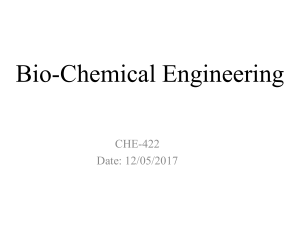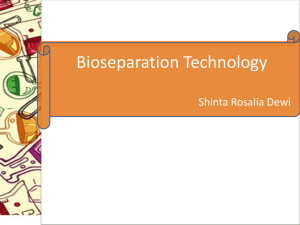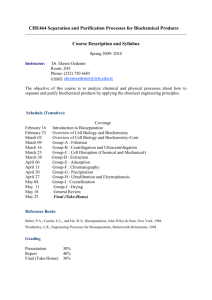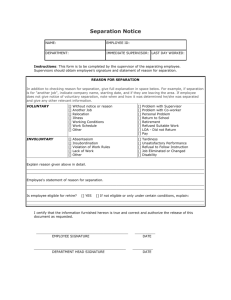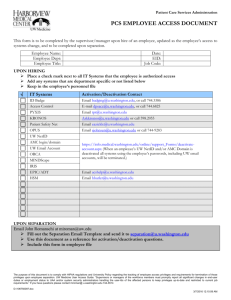What is separated in bioseparation?
advertisement
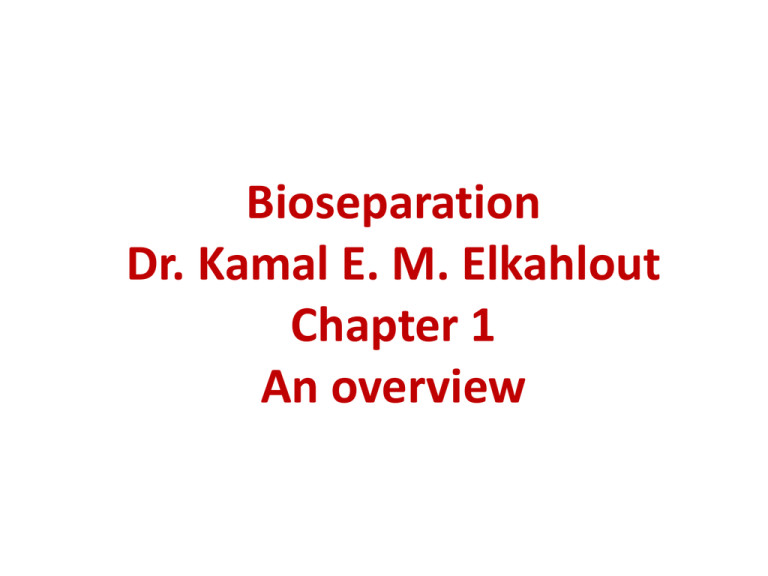
Bioseparation Dr. Kamal E. M. Elkahlout Chapter 1 An overview SEPARATION TECHNIQUES • Separation of one or more components from a complex mixture is a requirement for many operations in biotechnology industries. • The components ranges from particulate materials down to small molecules. • The separations aim to achieve removal of specific components, in order to increase the added value of the products, which may be the residue, the extracted components or both. • Bioseparations engineering refers to the systematic study of the scientific and engineering principles utilized for the large-scale purification of biological products. • Bioprocessing can be broadly classified into two categories (see Fig. 1.1): • 1. Reactive bioprocessing • 2. Extractive bioprocessing • In reactive bioprocessing, the bioseparation process follows some form of biological reaction whereas • extractive bioprocessing almost entirely involves bioseparation. • In the context of reactive bioprocessing, upstream processing involves steps such as biocatalyst screening, enrichment, isolation and propagation, cell manipulation by recombinant DNA technology or hybridoma technology, media optimization and ormulation, and so on. • The biological reaction involved could be fermentation , cell culture or simply an enzymatic reaction. • With extractive bioseparation, upstream processing involves raw material acquisition and pre-treatment. What is separated in bioseparation? • Biologically derived products can be categorized in different ways, one • way being based on their chemical nature (see Table 1.1). • Biological products can also be classified based on their intended applications (Table 1.2): Economic importance of bioseparation • The purification of biological products is technically difficult and expensive. • This could frequently be the critical limiting factor in the commercialization of a biological product. • Bioseparation cost can be a substantial component of the total cost of bioprocessing. • Table 1.3 summarizes the bioseparation cost of different categories of biological products. • For proteins and nucleic acids, particularly those used as biopharmaceuticals, the bioseparation cost is quite substantial. Nature of bioseparation • Bioseparation is largely based on chemical separation processes. • Comparison of separation processes used in bioseparations with more exhaustive classifications give the result in table 4. • This table shows that 80% of all the separation methods for conventional chemicals are practical in biotechnology. Table 4 classification Physical separations Equilibrium controlled separations Rate controlled separations total Used for all Used in conventiona bioseparations l chemicals 7 7 22 18 3 10 42 35 • Fundamental differences between synthetic chemicals and biological substances need to be kept in mind. • Some biologically derived substance such as antibiotics and other low molecular weight compounds such as vitamins and amino acids are purified using conventional separation techniques such as liquid-liquid extraction, packed bed adsorption, evaporation and drying. • Modified separation techniques are required for purifying more complex molecules such as proteins, lipids, carbohydrates and nucleic acids. • Bioseparation distinguishes chemical separation are attributed to: • 1. Biological products are present in very low concentration. • For example, monoclonal antibodies (0.1 mg/ml )in the mammalian cell culture supernatants. • Large volumes of dilute product streams have to be processed. • 2. Many impurities and may be by-products are present in the starting material and they have chemical and physical properties similar to those of the target product. • This makes separation extremely challenging. Hence, bioseparation has to be very selective in nature. • 3. There are stringent quality requirements for products used for prophylactic, diagnostic and therapeutic purposes both in terms of active product content as well as in terms of the absence of specific impurities. • Injectable therapeutic products should be free from endotoxins and pyrogens. Solutions for such specific requirements have to be built into a bioseparation process. • 4. Biological products are susceptible to denaturation and other • forms of degradation. • Therefore bioseparation techniques have to be "gentle" in terms of avoiding extremes of physicochemical conditions such as pH and ionic strengths, hydrodynamic conditions such as high shear rates, and exposure to gas-liquid interfaces. • Organic solvents which are widely used in chemical separations have relatively limited usage in bioseparations on account of their tendency to promote degradation of many biological products. • 5. Many biological products are thermolabile and hence many bioseparation techniques are usually carried out at sub-ambient • temperatures. • 6. Bioseparation is frequently based on multi-technique separation. • This will be discussed in detail in a subsequent section. Basis of separation in bioseparation processes • • • • • • • 1. Size: e.g. filtration, membrane separation, centrifugation. 2. Density: e.g. centrifugation, sedimentation, floatation. 3. Diffusivity: e.g. membrane separation. 4. Shape: e.g. centrifugation, filtration, sedimentation. 5. Polarity: e.g. extraction, chromatography, adsorption. 6. Solubility: e.g. extraction, precipitation, crystallization. 7. Electrostatic charge: e.g. adsorption, membrane separation, electrophoresis. • 8. Volatility: e.g. distillation, membrane distillation, pervaporation. Physical forms separated in bioseparation • Bioseparation usually involves the separation of the following physical forms: • Particle-liquid separation • Separation of cells from cell culture medium, the separation of blood cells from plasma in the manufacture of plasma proteins, and the removal of bacteria and viruses from protein solutions. • It can be achieved by forcing the suspension through a porous medium as in filtration and membrane separation. • It can also be achieved by subjecting the suspension to natural or artificially induced gravitational fields as in sedimentation, centrifugation and floatation. • Particle-particle separation in liquid medium • This process includes the fractionation of sub-cellular organelle, the separation of plasmid DNA from chromosomal DNA, and the separation of mature cells from young cells. • This type of separation can be achieved by zonal centrifugation which involves the introduction of the mixture at a location within a liquid medium which is then subjected to an artificially induced gravitational field. • As a result of this the heavier particles would migrate faster than the lighter particles, resulting in their segregation into distinct bands from which these particles can be subsequently recovered using • Particle-particle separation can in theory be carried out by using a porous medium which retains the bigger particles but allows the smaller particles to go through. • However, this sounds easier than it actually is and can only be carried out if the larger particles can be prevented from blocking the porous medium. • Particle-solute separation in liquid medium • An example of this is the separation of dissolved antibiotics from cells and cell debris present in fermentation broth. • The methods used for particle-solute separation are fundamentally similar to those used for solid-liquid separation on account of the fact that the solute remains dissolved in the liquid medium. • Solute-solvent separation • It is a common bioseparation process, aiming either the total or partial removal of a solvent from a solute product (e.g. protein concentration enrichment), or the removal of dissolved impurities from a liquid product, or the replacement of a solvent from a solution by another (i.e. solvent exchange). • A range of options are available for solute-solvent separation the easiest of these being evaporation and distillation. • However, these techniques involve the application of heat and cannot therefore be used for separation of biological materials which tend to be thermolabile. • Membranes which can retain dissolved material while allowing solvents through are widely used for this type of separation: a reverse osmosis membrane will retain small molecules and ions, a nanofiltration membrane will retain larger molecules such as vitamins, hormones and antibiotics, while an ultrafiltration membrane will retain macromolecules such as proteins and nucleic acids. • Another way of removing a solvent from a solute is by reversibly binding the solute on to a solid surface, this being referred to as adsorption. • An indirect method for solute-solvent separation is by inducing precipitation of the solute. • Solvent exchange can also be carried out by liquid-liquid extraction where the solute is transferred from a liquid to another with which the original solvent is immiscible. • Solute-solute separation in liquid medium • It is the most challenging form of separation, e.g., separation of serum albumin from other serum proteins. • Solute-solute separation can be achieved by selective adsorption, i.e. by selectively and reversibly binding the target solute on to a solid material. • Solute-solute separation can also be carried out by liquidliquid extraction, i.e. by contacting the solution with an immiscible liquid in which the target solute has high solubility. • With the advent of membranes, solute-solute separation has become a lot easier. • Nanofiltration, ultrafiltration and dialysis membranes can be used for such separations. • An indirect way of carrying out solute-solute separation is by precipitation, which involves the selective precipitation of the target solute. • Liquid-liquid separation • Liquid-liquid separation is required in the manufacture of solvents such as acetone and ethanol which typically have to be separated from an aqueous medium. If the solvent is immiscible with water, phase separation followed by decantation may be sufficient. • However, if the solvent is miscible with water (as in the case of ethanol), other separation methods have to be utilized. • With temperature stable and volatile solvents such as ethanol, distillation has been traditionally used. Bioseparation techniques • Table 1.4 categorizes bioseparation techniques into two broad groups. • As previously mentioned, a bioseparation process must combine high selectivity (or resolution) with high throughput (or productivity). • Quite clearly none of those listed in the table can deliver this on their own. • Hence bioseparation processes tend to be based on multiple techniques arranged such that both high-resolution and high-throughput can be obtained in an overall sense. The RIPP scheme • While developing a bioseparation process the following should be taken into consideration: • 1. The nature of starting material: e.g. a cell suspension, a crude protein solution • 2. The initial location of the target product: e.g. intracellular, extracellular, embedded in solid material such as inclusion bodies • 3. The volume or flow-rate of the starting material • 4. The relative abundance of the product in the starting material, i.e. its concentration relative to impurities • 5. The susceptibility to degradation e.g. its pH stability, sensitivity to high shear rates or exposure to organic solvents • 6. The desired physical form of the final product, e.g. lyophilized powder, sterile solution, suspension • 7. The quality requirements, e.g. percentage purity, absence of endotoxins or aggregates • 8. Process costing and economics • A RIPP (Recovery, Isolation, Purification and Polishing) scheme is commonly used in bioseparation. • This strategy involves use of low resolution techniques (e.g. precipitation, filtration, centrifugation, and crystallization) first for recovery and isolation followed by high resolution techniques (e.g. affinity separations, chromatography, and electrophoresis) for purification and polishing. • The high-throughput, low-resolution techniques are first used to significantly reduce the volume and overall concentration of the material being processed. • The partially purified products are then further processed by high-resolution low-throughput techniques to obtain pure and polished finished products. Example of bioseparation • A scheme for the bioseparation of reagent grade monoclonal antibody from cell culture supernatant is shown in Fig. 1.2. • Murine or mouse monoclonal antibodies are produced by culturing hybridoma cells in different types of bioreactors. • In recent years it has been possible to synthesize humanized and chimaeric monoclonal antibodies by culturing recombinant Chinese Hamster Ovarian (CHO) cells. • In the bioseparation scheme shown in Fig. 1.2, the key purification step involves affinity chromatography. • Prior to affinity chromatography the cell culture supernatant needs to be cleaned up by membrane filtration or centrifugation so that cells, cell debris and other particulate matter do not clog-up the affinity column. • The nearly purified monoclonal antibody obtained by affinity chromatography is further purified by ion-exchange chromatography and polished by gel-filtration to obtain greater than 98% pure product in the solution form. • This percentage purity figure is relative to other proteins present in the product. • The antibody solution is then filtered to remove bacterial contaminant and marketed either as a sterile solution or as a freeze dried powder. • The scheme for purifying therapeutic grade monoclonal antibodies would be largely similar to that shown in Fig. 1.2. • In addition to the basic purification scheme used for making the reagent grade monoclonal antibody, some additional steps for removing particulate matter and specific impurities such as endotoxins and antibody dimers and higher order aggregates would be required. • An additional step to formulate the monoclonal antibody in an appropriate buffer would also be required. Current trends in the bioseparation • The main disadvantages of using the RIPP scheme are: • 1. High capital cost • 2. High operations cost • 3. Lower recovery of product • With the advent of membrane separation processes and other new types of separations, the potential exists for avoiding the conventional RIPP scheme. Membrane processes give high throughput and can be fine-tuned or optimized to give very high selectivity. • The use of these new techniques can significantly cut down the number of steps needed for bioseparation. • Some of these new and emerging techniques are: • 1. Membrane and monolith chromatography • 2. Expanded-bed chromatography • 3. High-resolution ultrafiltration • 4. Hybrid bioseparations

